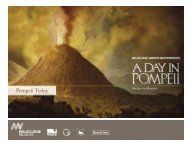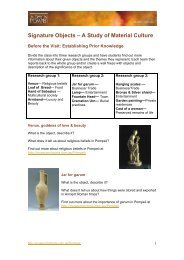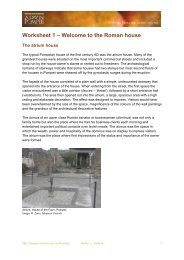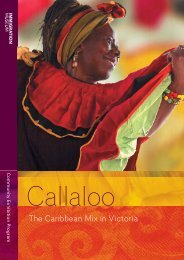Exhibition notes for A Day in Pompeii - Museum Victoria
Exhibition notes for A Day in Pompeii - Museum Victoria
Exhibition notes for A Day in Pompeii - Museum Victoria
You also want an ePaper? Increase the reach of your titles
YUMPU automatically turns print PDFs into web optimized ePapers that Google loves.
<strong>Exhibition</strong> Notes <strong>for</strong> A <strong>Day</strong> <strong>in</strong> <strong>Pompeii</strong><br />
http://museumvictoria.com.au/<strong>Pompeii</strong><br />
<strong>Exhibition</strong> Notes<br />
ORIGINS<br />
From small town to multicultural city on the move<br />
<strong>Pompeii</strong> is now world-famous, but this important historic site began as a small coastal<br />
settlement which covered about 10 hectares. As <strong>in</strong> many modern cities, the shape of the<br />
older town is still visible with<strong>in</strong> the grid of later construction. By the sixth century BC,<br />
however, the town had expanded to more than six times its orig<strong>in</strong>al size and was<br />
dom<strong>in</strong>ated by the Etruscans, though its culture also borrowed freely from the Greek<br />
cities of the region. Late <strong>in</strong> the fifth century BC, <strong>Pompeii</strong> changed hands aga<strong>in</strong>, this time<br />
thanks to Samnite tribesmen from the mounta<strong>in</strong>s, and it cont<strong>in</strong>ued to grow <strong>in</strong> wealth and<br />
sophistication as the Romans cont<strong>in</strong>ued their expansion through the Mediterranean.<br />
<strong>Pompeii</strong> was located near Italy’s largest port, Pozzuoli, and Pompeian merchants took<br />
advantage of this proximity to set up successful bus<strong>in</strong>esses and trade routes, particularly<br />
with Greece. The considerable wealth they brought home spurred a build<strong>in</strong>g boom <strong>in</strong><br />
<strong>Pompeii</strong> <strong>in</strong> the second century BC, and the cultural <strong>in</strong>fluence of Greek art and<br />
architecture on the villas these wealthy merchants built is obvious.<br />
ROMAN POMPEII<br />
A jewel <strong>in</strong> the crown of the Empire<br />
In 90 BC, a regional rebellion broke out aga<strong>in</strong>st the Romans, and a year later the Roman<br />
Dictator Sulla besieged and captured <strong>Pompeii</strong>. Reprisals followed, and <strong>Pompeii</strong><br />
trans<strong>for</strong>med itself aga<strong>in</strong>, this time <strong>in</strong>to a Roman colony. Lat<strong>in</strong> became the official<br />
language, and a Roman constitution was imposed on the new colony.<br />
By the time Augustus became the first Roman Emperor <strong>in</strong> 27 BC, prom<strong>in</strong>ent Pompeians<br />
had become devotees of Roman fashion and custom. <strong>Pompeii</strong> had come a long way<br />
from its humble orig<strong>in</strong>s. Now a bustl<strong>in</strong>g town, it was home to about 10,000-12,000<br />
people, with as many aga<strong>in</strong> liv<strong>in</strong>g <strong>in</strong> the surround<strong>in</strong>g countryside. As <strong>Pompeii</strong>’s<br />
population <strong>in</strong>creased, so did its urbanisation, as older houses were subdivided and<br />
upper storeys added to make room <strong>for</strong> the newcomers. The social structure underwent a<br />
shake-up, as the old rul<strong>in</strong>g aristocracy began to lose ground to a new class of self-made<br />
men who built larger and showier villas <strong>in</strong> the Roman style.<br />
BUSINESSES<br />
Boom<strong>in</strong>g bus<strong>in</strong>ess: <strong>Pompeii</strong> as a trad<strong>in</strong>g centre<br />
Its fertile and well-dra<strong>in</strong>ed volcanic soil and mild climate made <strong>Pompeii</strong> an agricultural<br />
hub, and her port and geographic position gave her easy access to markets near and<br />
far. The savvy Pompeians took advantage of these natural assets to make their town,<br />
and themselves, <strong>in</strong>to a trad<strong>in</strong>g power <strong>in</strong> the Mediterranean.<br />
The w<strong>in</strong>es of <strong>Pompeii</strong> were well known <strong>in</strong> the Roman world (although accord<strong>in</strong>g to the<br />
historian Pl<strong>in</strong>y, they produced equally notable hangovers). W<strong>in</strong>e must have been<br />
produced <strong>in</strong> great quantity as archaeologists still discover rustic villas complete with w<strong>in</strong>e<br />
presses throughout the region, and amphorae bear<strong>in</strong>g trade stamps from <strong>Pompeii</strong> have<br />
turned up as far away as Gaul (modern day France), Spa<strong>in</strong> and even Carthage <strong>in</strong> North<br />
Africa.<br />
1
http://museumvictoria.com.au/<strong>Pompeii</strong><br />
<strong>Exhibition</strong> Notes<br />
Pompeian farmers also specialised <strong>in</strong> grow<strong>in</strong>g vegetables, especially onions, <strong>for</strong> which<br />
the town was famous, and olives <strong>for</strong> oil. Herders raised sheep <strong>for</strong> their meat and milk as<br />
well as their wool – another important Pompeian product, which was cleaned, dyed and<br />
made <strong>in</strong>to felt at numerous fulleries (fullonica) <strong>in</strong> the city. <strong>Pompeii</strong>’s coastal location also<br />
made it a popular producer of garum, a fish sauce which was <strong>in</strong> great demand as a<br />
relish; jars conta<strong>in</strong><strong>in</strong>g Pompeian garum have been found as far afield as Gaul.<br />
Shops of all k<strong>in</strong>ds l<strong>in</strong>ed the bustl<strong>in</strong>g ma<strong>in</strong> streets of <strong>Pompeii</strong>; even today, they are<br />
identifiable by the rema<strong>in</strong>s of the slid<strong>in</strong>g shutters which merchants used to close their<br />
storefronts at night. The shopp<strong>in</strong>g <strong>in</strong> <strong>Pompeii</strong> was world-class <strong>for</strong> its time: when tally<strong>in</strong>g<br />
customers’ purchases, shopkeepers used standardised weights which had to be<br />
periodically checked aga<strong>in</strong>st the official weights kept <strong>in</strong> the Forum. The bakery was a<br />
daily stop <strong>for</strong> most residents; many bakeries conta<strong>in</strong>ed mills to gr<strong>in</strong>d their own gra<strong>in</strong>, and<br />
the bread was baked and sold on the same premises. Bars (cauponae) sell<strong>in</strong>g snacks<br />
and dr<strong>in</strong>ks were also common; they consisted of an L-shaped counter <strong>in</strong> which were<br />
sunk large jars, or dolia, conta<strong>in</strong><strong>in</strong>g foodstuffs. Sometimes they offered a back room <strong>for</strong><br />
customers to eat a meal, dr<strong>in</strong>k and perhaps even gamble. A number of <strong>in</strong>ns probably<br />
offered more <strong>in</strong>timate enterta<strong>in</strong>ment <strong>in</strong> the <strong>for</strong>m of prostitution, and archaeologists have<br />
even discovered a large purpose-built brothel, complete with small cubicles and wall<br />
pa<strong>in</strong>t<strong>in</strong>gs show<strong>in</strong>g the variety of services offered.<br />
WATER SUPPLY<br />
Water, water everywhere: <strong>Pompeii</strong>’s amaz<strong>in</strong>g aqueducts<br />
In its first several centuries as a town, <strong>Pompeii</strong> got most of its water from underground<br />
cisterns, which were fed by ra<strong>in</strong>water collected from roofs. One of the perks of be<strong>in</strong>g part<br />
of the Roman Republic, however, was hav<strong>in</strong>g access to all the latest technology, and <strong>in</strong><br />
the early first century AD <strong>Pompeii</strong> constructed an aqueduct system to br<strong>in</strong>g fresh, clean<br />
water from the hills 40 kilometres away. This water flowed <strong>in</strong>to a roofed reservoir<br />
(castellum aquae) be<strong>for</strong>e divid<strong>in</strong>g <strong>in</strong>to three large lead pipes which ran under the<br />
pavements. Six-metre-high towers with lead tanks on top were built at <strong>in</strong>tervals along<br />
these three pipel<strong>in</strong>es. The 35-metre height difference between the castellum and the<br />
lowest po<strong>in</strong>t <strong>in</strong> the city meant that the water <strong>in</strong> the pipes was under pressure, allow<strong>in</strong>g<br />
smaller pipes to carry water up to the tanks, then back down the towers to supply public<br />
founta<strong>in</strong>s, houses, shops and facilities such as baths.<br />
Water pipes usually entered houses at the front door and fed founta<strong>in</strong>s at the side of the<br />
impluvium or <strong>in</strong> the peristyle or garden — the early <strong>for</strong>erunner of the runn<strong>in</strong>g water <strong>in</strong> our<br />
homes today. Any overflow went <strong>in</strong>to a dra<strong>in</strong> which emerged <strong>in</strong> the road at the base of<br />
the kerbstones and was used to flush the streets of rubbish be<strong>for</strong>e end<strong>in</strong>g up <strong>in</strong> storm<br />
dra<strong>in</strong>s which carried it neatly to the river.<br />
Lavatories, while decidedly rare <strong>in</strong> other parts of the world at this time, were<br />
commonplace <strong>in</strong> sophisticated <strong>Pompeii</strong>, and often occupied a small room off the kitchen.<br />
In these hygienic marvels, a wooden seat was built over a lavatory pit, which, when<br />
flushed with a bucket of water, discharged <strong>in</strong>to a cesspit near the house or under the<br />
street.<br />
2
http://museumvictoria.com.au/<strong>Pompeii</strong><br />
<strong>Exhibition</strong> Notes<br />
PUBLIC BATHS<br />
Leisure time <strong>in</strong> cosmopolitan <strong>Pompeii</strong><br />
Bath<strong>in</strong>g <strong>in</strong> <strong>Pompeii</strong> was a public activity, not a private one, and the public baths were<br />
important social meet<strong>in</strong>g places. They were so important, <strong>in</strong> fact, that <strong>Pompeii</strong> (which<br />
had only 12,000 residents) boasted three major bath<strong>in</strong>g complexes: the Stabian baths,<br />
which were the oldest; the Forum baths, built after 80 BC; and the Suburban baths, built<br />
<strong>in</strong> the early first century AD. A fourth, the Central baths, was under construction, but was<br />
still <strong>in</strong>complete at the time of the 79 AD eruption.<br />
At the baths, men and women had separate areas; if there were no separate facilities,<br />
women bathed <strong>in</strong> the morn<strong>in</strong>g and men <strong>in</strong> the afternoon. In addition to the ma<strong>in</strong> bath<strong>in</strong>g<br />
block, which had facilities <strong>for</strong> hot, warm and cold bath<strong>in</strong>g, there was usually an adjo<strong>in</strong><strong>in</strong>g<br />
gymnasium <strong>for</strong> exercise. After the aqueduct system was built and a plentiful water<br />
supply was assured, an open-air swimm<strong>in</strong>g pool was even added to the Stabian baths.<br />
The procedure most Pompeians followed was to undress <strong>in</strong> the apodyterium, oil their<br />
bodies and then exercise <strong>in</strong> the gymnasium. After exercis<strong>in</strong>g, oil and sweat was scraped<br />
off with a curved tool called a strigil, then followed up with a series of baths, start<strong>in</strong>g <strong>in</strong><br />
the hottest pool and work<strong>in</strong>g their way via the warm pool to end with a brac<strong>in</strong>g dip <strong>in</strong> the<br />
cold pool. Furnaces beh<strong>in</strong>d the hot rooms supplied the heat <strong>for</strong> the hot baths; it<br />
circulated under the hollow floors and rose up through cavities <strong>in</strong> the walls, f<strong>in</strong>ally<br />
escap<strong>in</strong>g by means of chimneys <strong>in</strong> the vault.<br />
PRIVATE RESIDENCES<br />
What does a 2,000-year-old house look like, anyway?<br />
In some ways, Pompeian houses were very different to those we live <strong>in</strong> today. For one<br />
th<strong>in</strong>g, <strong>in</strong> <strong>Pompeii</strong>, all the liv<strong>in</strong>g rooms of the house faced <strong>in</strong>ward. Instead of hav<strong>in</strong>g a front<br />
garden or even a gate, the front door opened directly onto the pavement, and the rooms<br />
to either side of the door were usually either utility rooms or a shopfront. From the front<br />
door, a passage led back to the largest room <strong>in</strong> the house, the atrium, which was lit by a<br />
rectangular aperture (compluvium) <strong>in</strong> the middle of its high, wooden roof. Ra<strong>in</strong>water fell<br />
through this open skylight <strong>in</strong>to a rectangular bas<strong>in</strong> (impluvium) <strong>in</strong> the floor beneath, and<br />
ran <strong>in</strong>to a storage cistern under the floor — an arrangement similar to our modern water<br />
tanks, though almost certa<strong>in</strong>ly more attractive! Private rooms, which often conta<strong>in</strong>ed<br />
couches, were situated to either side of the atrium, and at the far end lay the three most<br />
important rooms: the outer tricl<strong>in</strong>ia, or d<strong>in</strong><strong>in</strong>g rooms, and the central tabl<strong>in</strong>um, a <strong>for</strong>mal<br />
reception room used by the master of the house <strong>for</strong> bus<strong>in</strong>ess and greet<strong>in</strong>g guests.<br />
The doors to the house were thrown open at an early hour to admit the family<br />
dependents (clientes) who had been wait<strong>in</strong>g patiently on the benches beside the front<br />
door.<br />
Pompeian architecture was clearly more homogeneous than our modern houses today;<br />
most, if not all, of the private dwell<strong>in</strong>gs found <strong>in</strong> the city con<strong>for</strong>m to this basic Roman<br />
layout. However, the wealthier citizens of <strong>Pompeii</strong> were <strong>in</strong> many ways as attuned to style<br />
and fashion as we are today, and newer houses were built to con<strong>for</strong>m to the latest<br />
trends.<br />
The so-called First Pompeian Style used the <strong>for</strong>mal, austere atrium as a showplace to<br />
impress visitors with grand decorations of moulded plaster pa<strong>in</strong>ted to imitate polychrome<br />
marble blocks. All manner of bus<strong>in</strong>ess was conducted <strong>in</strong> the atrium, so it was designed<br />
3
http://museumvictoria.com.au/<strong>Pompeii</strong><br />
<strong>Exhibition</strong> Notes<br />
to display the family’s wealth, piety and l<strong>in</strong>eage. Beyond the <strong>for</strong>mal atrium lay the<br />
peristyle — a garden surrounded by colonnades which was a less <strong>for</strong>mal, more richly<br />
decorated part of the house, a place to relax or d<strong>in</strong>e. Many houses were built <strong>in</strong> this style<br />
between the third and second centuries BC, a time when the aristocracy still held sway.<br />
After the establishment of the Roman military colony <strong>in</strong> 80 BC, the illusionistic Second<br />
Style, which opened up the walls with columns and architectural vistas, became popular.<br />
Towards the end of the first century BC, illusion was abandoned and the delicate and<br />
exquisite Third Style was <strong>in</strong> vogue.<br />
In the first century AD, Pompeians began to build upper storeys onto build<strong>in</strong>gs and carve<br />
small apartments out of larger houses. This may have been an attempt to cope with a<br />
grow<strong>in</strong>g population, to house the families of emancipated slaves, or simply to create<br />
rooms <strong>for</strong> rent. Decoration <strong>in</strong> the atrium and the surround<strong>in</strong>g rooms also became more<br />
showy, perhaps when older houses came <strong>in</strong>to the hands of self-made men who had no<br />
ancestry to boast of. After the aqueduct was built, fashionable homeowners also<br />
constructed elaborate garden areas, as found <strong>in</strong> the House of D. Octavius Quartio,<br />
which boasts founta<strong>in</strong>s, watercourses, pavilions and <strong>for</strong>mal plant<strong>in</strong>gs extend<strong>in</strong>g the<br />
length of its vast garden. In smaller houses where space was limited, fantasy<br />
landscapes were pa<strong>in</strong>ted on blank walls to open up imag<strong>in</strong>ary vistas and give an<br />
impression of space.<br />
In the last years of the city, the rich and complex Fourth Style returned to the earlier<br />
fashion of ‘open<strong>in</strong>g’ walls us<strong>in</strong>g illusionistic decoration, but with an even greater<br />
emphasis on creat<strong>in</strong>g a fantasy world.<br />
FOOD AND DINING<br />
A moveable feast: Pompeian kitchens and d<strong>in</strong><strong>in</strong>g<br />
In today’s houses, the kitchen tends to be a central feature, often used <strong>for</strong> eat<strong>in</strong>g and<br />
gather<strong>in</strong>g with friends as well as cook<strong>in</strong>g. In contrast, Roman kitchens were small,<br />
poorly lit rooms, usually tucked away at the back of the house. In most of the kitchens<br />
excavated at <strong>Pompeii</strong>, the only permanent feature left is a masonry hearth with a tiled<br />
top and arched recesses at the bottom <strong>for</strong> stor<strong>in</strong>g fuel. Cook<strong>in</strong>g was done on this open<br />
hearth, with pots set on iron tripods over burn<strong>in</strong>g charcoal or wood. Some houses also<br />
boasted a small oven, much like a modern woodfired pizza oven, at the corner of the<br />
bench, with a vent near the stove <strong>for</strong> the smoke to escape. The only other furnish<strong>in</strong>gs <strong>in</strong><br />
the Pompeian kitchen were a bas<strong>in</strong> to hold water <strong>for</strong> cook<strong>in</strong>g and wash<strong>in</strong>g up, and<br />
sometimes supports <strong>for</strong> tables to prepare the food.<br />
Roman kitchen implements were simple, but practical and functional. Texts of the time<br />
use the word cacabus to mean pans <strong>in</strong> general, while the fretale or sartago seems to<br />
have been a bronze or iron fry<strong>in</strong>g pan. The pultarius was a saucepan, and the testa or<br />
clibanus a small portable oven <strong>for</strong> roast<strong>in</strong>g or bak<strong>in</strong>g bread. Iron choppers, knives,<br />
cleavers and spoons, as well as stra<strong>in</strong>ers, ladles and mortars, were used to prepare the<br />
food, which was served on a large circular platter called a discus. Portable hearths of<br />
bronze or ceramic could be used <strong>in</strong> apartments or <strong>for</strong> a summer meal <strong>in</strong> the garden,<br />
and a craticula was a special grid used <strong>for</strong> barbecues.<br />
4
http://museumvictoria.com.au/<strong>Pompeii</strong><br />
<strong>Exhibition</strong> Notes<br />
Roman cuis<strong>in</strong>e was also decidedly simple: food of all sorts was usually boiled, smoked,<br />
fried or baked and either seasoned with fish sauce (garum) or w<strong>in</strong>e reduced to a thick<br />
syrup (defrutum) and thickened with starch (amulum).<br />
Lunch (prandium), taken at midday, was a light meal consist<strong>in</strong>g of meat or fish and fruit<br />
with perhaps some w<strong>in</strong>e. Guests were not usually <strong>in</strong>vited to prandium. Dur<strong>in</strong>g the hot<br />
Pompeian summer, this was followed by a siesta (meridiatio). The afternoon was the<br />
time <strong>for</strong> bath<strong>in</strong>g, and after the baths (which might take several hours), the Pompeians<br />
ate their ma<strong>in</strong> meal (cena). As <strong>in</strong> any modern town, it was always possible to eat out at<br />
an <strong>in</strong>n (taberna). The menu (tabula lusoria) was displayed outside to entice passersby,<br />
and <strong>in</strong> one well-preserved <strong>in</strong>stance, offered an impressive choice of chicken, fish and<br />
ham.<br />
Wealthy Pompeians d<strong>in</strong>ed <strong>in</strong> great style, and often had several d<strong>in</strong><strong>in</strong>g rooms to choose<br />
from: cold-weather d<strong>in</strong><strong>in</strong>g rooms faced west to take advantage of the warm afternoon<br />
sun, and warm-weather rooms faced east or north <strong>in</strong> order to rema<strong>in</strong> shaded <strong>for</strong> most of<br />
the day. Many of the larger houses also had outdoor d<strong>in</strong><strong>in</strong>g areas with a pergola to<br />
shade the d<strong>in</strong>ers and usually a founta<strong>in</strong> nearby. D<strong>in</strong>ers wore brightly coloured d<strong>in</strong>ner<br />
suits called cenatoria and recl<strong>in</strong>ed on couches. The classical Roman d<strong>in</strong><strong>in</strong>g<br />
arrangement consisted of three large couches (the summus, medius and imus), each of<br />
which seated three people. The host sat at the end of the leftmost couch (imus) and the<br />
guest of honour sat at the left of the middle couch (medius). The food was served <strong>in</strong><br />
bite-sized pieces, and d<strong>in</strong>ers ate from small plates placed on a ledge <strong>in</strong> front of them,<br />
us<strong>in</strong>g spoons or their f<strong>in</strong>gers. The first course (gustatio) usually <strong>in</strong>cluded eggs, lettuce,<br />
cheese and olives. The ma<strong>in</strong> course (primae mensae) consisted of fish or meat such as<br />
ham, poultry or kid. The last course (mensae secundae) was usually fruit. On special<br />
occasions, the wealthy would serve spectacular dishes like ‘Trojan Pig’, which when<br />
split open revealed a hidden fill<strong>in</strong>g of sausages and black pudd<strong>in</strong>g. Oysters were a<br />
popular addition to the menu, and an enterpris<strong>in</strong>g Roman, Sergius Orata, pioneered<br />
oyster farm<strong>in</strong>g <strong>in</strong> the Lucr<strong>in</strong>e Lake <strong>in</strong> about 100 BC.<br />
ENTERTAINMENT<br />
Fight club: the importance of the amphitheatre<br />
Aside from the daily bath<strong>in</strong>g ritual, the spectacles of the amphitheatre were the most<br />
popular <strong>for</strong>m of enterta<strong>in</strong>ment <strong>in</strong> <strong>Pompeii</strong>. <strong>Pompeii</strong>’s amphitheatre was built sometime<br />
after 80 BC, mak<strong>in</strong>g it the oldest known example of its k<strong>in</strong>d <strong>in</strong> the Roman world. The<br />
contests Pompeians enjoyed were ultra-violent even by today’s standards, rang<strong>in</strong>g from<br />
gladiator versus gladiator combat to fights that pitted men aga<strong>in</strong>st various dangerous<br />
animals.<br />
Spectacles took place <strong>in</strong> the arena of the amphitheatre and often lasted two or three<br />
days. They were highly publicised and well attended, not only by the citizens of <strong>Pompeii</strong><br />
but also by people from neighbour<strong>in</strong>g towns, and sometimes became just as rowdy as<br />
modern sport<strong>in</strong>g events. In 59 AD a riot broke out <strong>in</strong> the amphitheatre between<br />
Pompeian fans and the people of nearby Nuceria, and as a result the amphitheatre was<br />
closed <strong>for</strong> ten years – a hefty penalty <strong>for</strong> the crime. The riot is celebrated <strong>in</strong> a graffito<br />
found on the facade of the House of the Dioscuri, which portrays a triumphant gladiator<br />
carry<strong>in</strong>g a palm of victory and say<strong>in</strong>g, "Campanians, you perished with the Nucerians <strong>in</strong><br />
our victory." (The region surround<strong>in</strong>g Mount Vesuvius was called Campania). Other<br />
Pompeian graffiti have been found depict<strong>in</strong>g gladiatorial contests and list<strong>in</strong>g the victories<br />
5
http://museumvictoria.com.au/<strong>Pompeii</strong><br />
<strong>Exhibition</strong> Notes<br />
of favourite gladiators. These gladiators were often <strong>for</strong>eign slaves, and both men and<br />
women idolised them; one graffito reads: "Celadus the Thracian makes all the girls sigh."<br />
Theatrical per<strong>for</strong>mances were another, gentler <strong>for</strong>m of popular enterta<strong>in</strong>ment. <strong>Pompeii</strong>’s<br />
theatre was an old one, built <strong>in</strong> the second century BC <strong>in</strong> the Greek style and then<br />
enlarged and modernised <strong>in</strong> the Augustan period to make it more like a Roman theatre.<br />
Comedies and rustic farces were per<strong>for</strong>med there, as well as mimed re-enactments of<br />
mythological scenes. The dramas of ancient Greece must also have been popular,<br />
judg<strong>in</strong>g from the wall pa<strong>in</strong>t<strong>in</strong>gs depict<strong>in</strong>g the famous Greek playwright Menander. A<br />
small roofed odeum, or concert hall, was built next to the theatre <strong>in</strong> about 75 BC to<br />
provide an additional venue <strong>for</strong> musical enterta<strong>in</strong>ment.<br />
FASHION<br />
High fashion and heavenly adornment, Roman-style<br />
<strong>Pompeii</strong> was a hub of trade and travel, and its wealthier residents were knowledgeable<br />
about all the latest fashion and beauty trends from Rome and beyond. The standard<br />
garment <strong>for</strong> women throughout the Roman Empire was the stola, a long pleated dress<br />
that was draped around the body and p<strong>in</strong>ned together with brooches (fibulae). The style<br />
of this garment was traditional and didn’t vary much, which made make-up and<br />
hairstyl<strong>in</strong>g even more important as a way to express a woman’s beauty and <strong>in</strong>dividuality.<br />
The Roman beauty ideal was a white face, bright red lips and very dark eyes. To<br />
achieve this look, women used foundation creams and face powder made from white<br />
lead or powdered chalk and animal fat. Lipstick was made from ochre or molluscs, and<br />
eyel<strong>in</strong>er from soot or antimony powder. Fashionable women washed <strong>in</strong> water perfumed<br />
with c<strong>in</strong>namon and balsam, and often used ass’s milk on the sk<strong>in</strong> to prevent wr<strong>in</strong>kles.<br />
Other oil-based scents were derived from spices and herbs like cardamom, saffron,<br />
lavender, rose and orange, and were stored <strong>in</strong> small, tightly-stoppered glass bottles.<br />
Mirrors made from highly polished bronze or silver were, of course, essential items <strong>in</strong> the<br />
wealthy woman’s beauty kit.<br />
The blond hair of Celtic women (usually slaves) was particularly prized <strong>for</strong> mak<strong>in</strong>g wigs,<br />
but when this was not available, many women dyed their hair blonde and used hairnets<br />
of f<strong>in</strong>e gold thread and hairp<strong>in</strong>s of bone to hold their often elaborate hairstyles <strong>in</strong> place.<br />
Fashions <strong>in</strong> hairdress<strong>in</strong>g changed rapidly, much as they do today. In <strong>Pompeii</strong>’s early<br />
years, women favoured simple chignons or buns at the back of the head, or plaits tied<br />
back <strong>in</strong> a band, but <strong>in</strong> the last years of <strong>Pompeii</strong> built-up hairstyles became popular.<br />
These were very complex and often required several slaves work<strong>in</strong>g at the same time,<br />
manipulat<strong>in</strong>g hairpieces and false curls to produce a tower<strong>in</strong>g head of hair.<br />
Both men and women wore r<strong>in</strong>gs <strong>for</strong> adornment, which could be made from pla<strong>in</strong> gold,<br />
bronze, copper or silver. More elaborate jewellery featured pearls or gemstones such as<br />
cornelian, lapis lazuli or onyx, and the most detailed pieces featured delicately carved<br />
cameo or <strong>in</strong>taglio stones. Hoop earr<strong>in</strong>gs and gold bracelets with a coil<strong>in</strong>g snake design<br />
were especially popular.<br />
6
http://museumvictoria.com.au/<strong>Pompeii</strong><br />
<strong>Exhibition</strong> Notes<br />
MEDICINE<br />
Thoroughly modern medic<strong>in</strong>e<br />
The wealthier citizens of <strong>Pompeii</strong> had access to surpris<strong>in</strong>gly sophisticated medical care.<br />
In fact, the Romans had begun learn<strong>in</strong>g about medic<strong>in</strong>e centuries earlier, around the end<br />
of the third century BC, when the first Greek doctor came to Rome.<br />
At first, the ‘practice’ of medic<strong>in</strong>e was just that: methods were based on trial and error,<br />
and anyone could call himself a doctor. Many medical practitioners were slaves, and as<br />
a result the profession did not enjoy a high reputation. However, these experimental<br />
doctors’ methods improved over the years, as successful treatments were noted and<br />
passed on. Roman doctors began to study the works of Hippocrates (the Greek<br />
physician known as the ‘father of medic<strong>in</strong>e’) and by the time of Augustus the Romans<br />
were writ<strong>in</strong>g their own medical texts.<br />
Roman doctors used a great variety of medic<strong>in</strong>al plants, <strong>in</strong>clud<strong>in</strong>g morph<strong>in</strong>e extracted<br />
from opium poppies to take away pa<strong>in</strong>. They made prostheses to replace lost limbs, set<br />
broken bones and per<strong>for</strong>med many k<strong>in</strong>ds of surgery. One popular procedure was<br />
treph<strong>in</strong>ation – drill<strong>in</strong>g holes <strong>in</strong> the patient’s skull to relieve pressure. Even cosmetic<br />
surgery was per<strong>for</strong>med <strong>for</strong> the wealthy.<br />
Roman surgical <strong>in</strong>struments were strik<strong>in</strong>gly similar to modern ones, and used <strong>for</strong> many<br />
of the same purposes: steel or bronze scalpels to make <strong>in</strong>cisions, blunt hooks as probes<br />
<strong>for</strong> dissection, sharp hooks to lift pieces of tissue, <strong>for</strong>ceps to extract small pieces of<br />
bone, and bone saws <strong>for</strong> the heavy work of per<strong>for</strong>m<strong>in</strong>g amputations. These pioneer<strong>in</strong>g<br />
surgeons also used catheters to remove blockages <strong>in</strong> the ur<strong>in</strong>ary tract and bleed<strong>in</strong>g cups<br />
to remove blood <strong>in</strong> an attempt to rid the body of disease. An impressive set of 40<br />
surgical <strong>in</strong>struments was found <strong>in</strong> the aptly named House of the Surgeon at <strong>Pompeii</strong>.<br />
Although hygiene was improperly understood <strong>in</strong> Roman times, the extensive aqueduct<br />
systems delivered fresh water to millions and helped prevent water-borne diseases, as<br />
did the sophisticated toilet and sewerage systems which carried wastes away from<br />
densely populated areas. (Ironically, the lead pipes which carried the water posed their<br />
own health threat, a fact which was known to the Romans.) They may have had no cure<br />
<strong>for</strong> lead poison<strong>in</strong>g, but they were clearly aware that good food and exercise were<br />
important <strong>in</strong> ma<strong>in</strong>ta<strong>in</strong><strong>in</strong>g a healthy body. In fact, the Roman medical system was so<br />
advanced that it rema<strong>in</strong>ed unsurpassed until the n<strong>in</strong>teenth century, and the snake (the<br />
symbol of Aesculapius, the Greek god of medic<strong>in</strong>e) is associated with the medical<br />
profession to this day.<br />
RELIGION<br />
Cult follow<strong>in</strong>g: the importance of the gods <strong>in</strong> daily life<br />
The Pompeians worshipped many gods, primarily Graeco-Roman deities such as Jupiter<br />
(the Greek Zeus), Juno (Hera), M<strong>in</strong>erva (Athena) and Apollo. The oldest temple <strong>in</strong><br />
<strong>Pompeii</strong>, which dates to the sixth century BC, may have been a temple of M<strong>in</strong>erva. A<br />
temple of Apollo stands next to the Forum and a temple of Jupiter at its north end, both<br />
built <strong>in</strong> the second century BC. In about 80 BC, a temple of Venus was built on high<br />
ground <strong>in</strong> the southwest corner of the city overlook<strong>in</strong>g the sea, from which mythology<br />
tells us the goddess was born.<br />
7
http://museumvictoria.com.au/<strong>Pompeii</strong><br />
<strong>Exhibition</strong> Notes<br />
Roman temples were designed to house cult statues of the god or goddess to which<br />
they were dedicated; unlike most churches today, they were not usually entered by the<br />
worshippers. Instead, priests venerated the gods with processions and sacrifices on the<br />
altar, which stood <strong>in</strong> front of the temple. The Romans believed it was crucial to per<strong>for</strong>m<br />
these important rituals correctly, and the only way to know whether the god had been<br />
appeased was by div<strong>in</strong>ation, which meant exam<strong>in</strong><strong>in</strong>g the livers of sacrificial animals and<br />
the direction <strong>in</strong> which birds flew or how they ate <strong>in</strong> order to <strong>in</strong>terpret the god’s mood and<br />
<strong>in</strong>tentions.<br />
In addition to the public temples, most houses had a small shr<strong>in</strong>e or lararium, where<br />
daily ceremonials and rituals were per<strong>for</strong>med to appease the lares and penates who<br />
guarded the house. The lares (household gods) are usually depicted on these shr<strong>in</strong>es<br />
dressed <strong>in</strong> short tunics and carry<strong>in</strong>g dr<strong>in</strong>k<strong>in</strong>g horns and w<strong>in</strong>e buckets.<br />
As Rome’s empire spread, several new religions spread to <strong>Pompeii</strong> from overseas. The<br />
Egyptian cult of Isis was popular <strong>in</strong> <strong>Pompeii</strong> be<strong>for</strong>e the Roman colony was established <strong>in</strong><br />
80 BC, and appealed especially to the poor and oppressed, thanks to its story of death<br />
and resurrection and the promise of immortality. In the mythology, Osiris, the husband of<br />
Isis, is killed, and the tears of his griev<strong>in</strong>g wife cause the Nile to flood; however, her<br />
magical skills enable her to br<strong>in</strong>g Osiris back to life. When it was first discovered, the<br />
Temple of Isis at <strong>Pompeii</strong> was <strong>in</strong> exceptionally f<strong>in</strong>e condition, with most of the temple<br />
vessels and fitt<strong>in</strong>gs still <strong>in</strong> place. At the time of the eruption, the priests had tried to save<br />
the treasures of the temple, and the body of one of them was found next to a bag of gold<br />
near the Via dell’Abbondanza, (Street of Abundance).<br />
The Bacchic cult also became highly popular <strong>in</strong> this v<strong>in</strong>eyard-surrounded city, perhaps<br />
because it advocated extensive dr<strong>in</strong>k<strong>in</strong>g of w<strong>in</strong>e, which was thought to <strong>in</strong>duce religious<br />
ecstasy. One famous room <strong>in</strong> the Villa of the Mysteries depicts the god Bacchus<br />
<strong>in</strong>itiat<strong>in</strong>g members <strong>in</strong>to his secret society.<br />
Even a brand-new religion called Christianity found its way to <strong>Pompeii</strong>, perhaps along<br />
with the <strong>in</strong>flux of Jewish slaves to Italy after Jerusalem was sacked <strong>in</strong> 70 AD. At least<br />
some Bible stories seem to have been familiar to Pompeians; one <strong>in</strong>scription mentions<br />
Sodom and Gomorrah, and a pa<strong>in</strong>t<strong>in</strong>g <strong>in</strong> the House of the Physician shows a parody of<br />
the Judgment of Solomon with the characters depicted as dwarfs. A number of Semitic<br />
names have also been found <strong>in</strong> other <strong>in</strong>scriptions at <strong>Pompeii</strong>, <strong>in</strong>clud<strong>in</strong>g Jeshua, Jonas,<br />
‘Maria, a textile worker, and Martha, a slave’. Christianity was still young when <strong>Pompeii</strong><br />
was destroyed, but St Paul wrote dur<strong>in</strong>g his voyage from Malta to Rome <strong>in</strong> 62 AD, “… on<br />
the second day we came to Puteoli. There we found brethren, and were <strong>in</strong>vited to stay<br />
with them <strong>for</strong> seven days.” (Acts, 28:14). Puteoli is close to <strong>Pompeii</strong>, so it is possible that<br />
some Pompeians had also converted to Christianity, but no proof of this has yet been<br />
discovered.<br />
BURIAL PRACTICES<br />
The journey to eternity<br />
The roads lead<strong>in</strong>g out of <strong>Pompeii</strong> are l<strong>in</strong>ed with tombs, not <strong>for</strong> any om<strong>in</strong>ous reason, but<br />
because burial with<strong>in</strong> the city walls was not permitted. The best-known tombs l<strong>in</strong>e the<br />
road to Herculaneum. Be<strong>for</strong>e the Roman colony was established, Pompeians buried<br />
their dead <strong>in</strong> simple stone or brick cists (caskets or conta<strong>in</strong>ers), but after 80 BC<br />
cremation became the norm and wealthier Pompeians started to build more monumental<br />
8
http://museumvictoria.com.au/<strong>Pompeii</strong><br />
<strong>Exhibition</strong> Notes<br />
tombs, sometimes <strong>in</strong>clud<strong>in</strong>g an upper storey that featured statues of the deceased<br />
between columns. One particularly elaborate tomb built <strong>for</strong> a woman named Naevoleia<br />
Tyche boasts relief sculptures show<strong>in</strong>g the good works per<strong>for</strong>med by her husband, a<br />
freedman, as well as a ship represent<strong>in</strong>g trade, the source of her wealth. Another tomb<br />
features a wall-pa<strong>in</strong>t<strong>in</strong>g show<strong>in</strong>g the family silver. Some of the tombs rest with<strong>in</strong> walled<br />
enclosures, and one unusual type of burial is marked by a tombstone with a pla<strong>in</strong><br />
circular top resembl<strong>in</strong>g a human head. In the early first century BC a number of<br />
commemorative curved stone benches were also built <strong>in</strong> these cemeteries, but<br />
archaeologists are not sure whether these were actual burial places or cenotaphs<br />
erected to honour dead who lie elsewhere.<br />
VESUVIUS ERUPTS<br />
The end of an era<br />
In 62 AD, a severe earthquake caused great devastation <strong>in</strong> <strong>Pompeii</strong>. This should have<br />
served as a warn<strong>in</strong>g of the disaster to come, but it went unheeded by the locals, who<br />
were accustomed to feel<strong>in</strong>g the earth tremble and considered it the work of the gods.<br />
Instead, the city optimistically began to rebuild, and this work was still underway when<br />
Vesuvius erupted <strong>in</strong> spectacular fashion on 24 August 79 AD. The massive explosion<br />
sent a column of hot ash thousands of metres <strong>in</strong>to the air, and triggered pyroclastic flows<br />
which rampaged down the mounta<strong>in</strong>side at over 200 kilometres an hour, destroy<strong>in</strong>g<br />
everyth<strong>in</strong>g <strong>in</strong> their path. Soon, what had been a vibrant city was completely buried under<br />
up to 10 metres of volcanic ash.<br />
Despite the scale of the destruction, however, many of <strong>Pompeii</strong>’s residents managed to<br />
escape <strong>in</strong> the first hours of the eruption: overall, fewer than 2,000 people died. In the<br />
months that followed, the Emperor Titus offered aid to the devastated region, and<br />
survivors returned to the wasteland that had been their home. Parts of build<strong>in</strong>gs still<br />
protruded through the ash, and the refugees used these to p<strong>in</strong>po<strong>in</strong>t landmarks and dig<br />
down to recover their belong<strong>in</strong>gs or simply to plunder what rema<strong>in</strong>ed.<br />
BODY CASTS<br />
Frozen <strong>in</strong> time: <strong>Pompeii</strong>’s unique legacy<br />
In 1860, the Italian archaeologist Giuseppe Fiorelli noticed that long-decomposed<br />
organic material had left voids <strong>in</strong> the volcanic ash which covered <strong>Pompeii</strong>, and devised a<br />
way to fill them with plaster. This technique produced startl<strong>in</strong>gly realistic casts of human<br />
be<strong>in</strong>gs and animals frozen <strong>in</strong> their death agonies, which cont<strong>in</strong>ue to disturb and <strong>in</strong>trigue<br />
us today. Some of the most poignant examples are an embrac<strong>in</strong>g couple and a writh<strong>in</strong>g<br />
dog, cha<strong>in</strong>ed and unable to escape — true snapshots of mortality, miraculously<br />
preserved <strong>in</strong>tact <strong>for</strong> nearly 2,000 years.<br />
In 1984, archaeologists developed a new technique which used epoxy res<strong>in</strong> <strong>in</strong>stead of<br />
plaster. The transparent res<strong>in</strong> allows scientists to see the skeleton and teeth of the<br />
figure, and <strong>in</strong> the case of a woman at Oplontis, even the jewellery she was wear<strong>in</strong>g is<br />
visible. These figures are both mov<strong>in</strong>g and powerful, unwill<strong>in</strong>g messengers from the<br />
distant past who <strong>in</strong> their deaths have provided us with a unique w<strong>in</strong>dow on their ancient<br />
lives.<br />
9


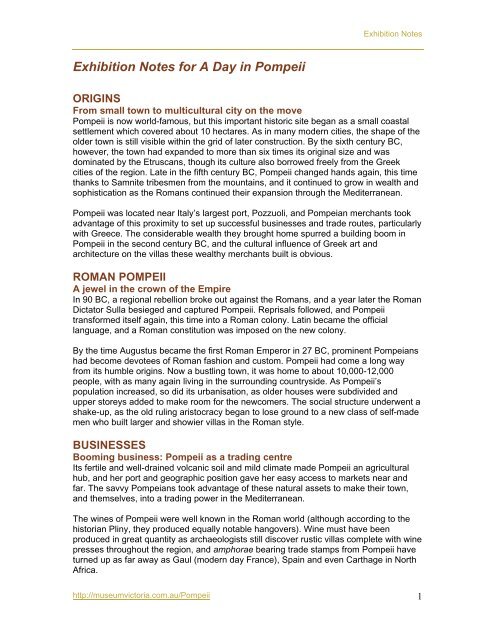



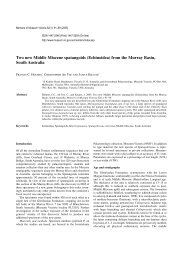
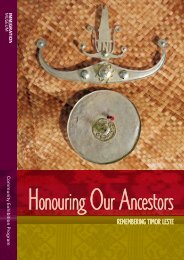
![[PDF] Andiamo a Pompei- Teacher Notes ... la - Museum Victoria](https://img.yumpu.com/16309810/1/190x245/pdf-andiamo-a-pompei-teacher-notes-la-museum-victoria.jpg?quality=85)

